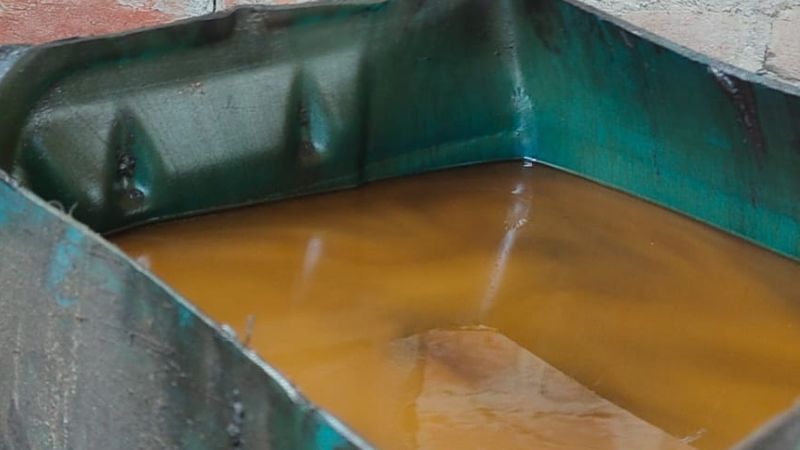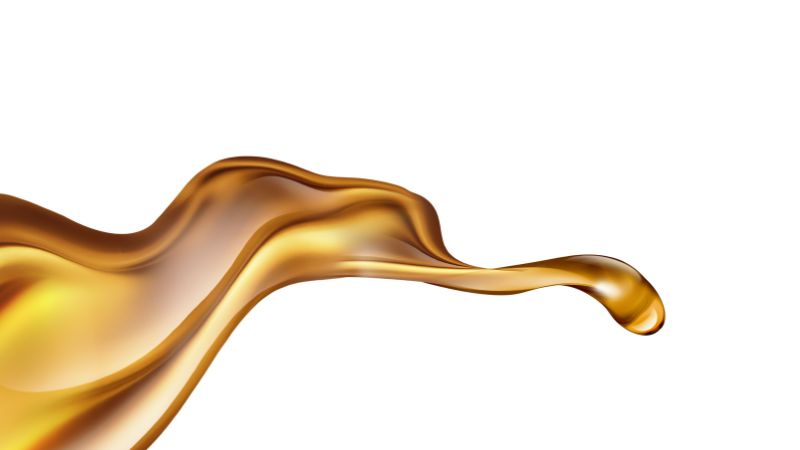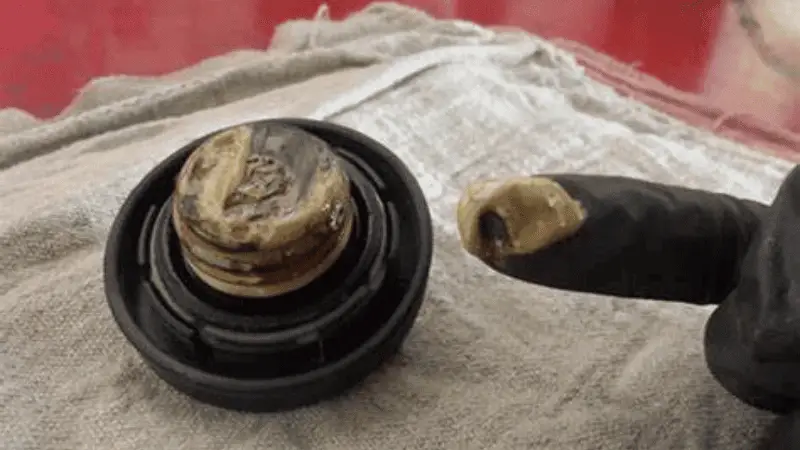Every engine needs proper and regular oil changes. But when you see a liquid or milky oil, something is wrong, which is the sign. After seeing this, you should fix it or take some immediate action. But most people want to learn how to fix milky oil in an engine.
It would help to act fast when your engine oil looks brown or cloudy. Milky motor oil means water is mixed with the lubricant when there shouldn’t be.
Besides this, it also means that you have water in the oil gallery cylinder or even injectors. However, from this article, you can learn the causes of milky oil and how to fix milky engine oil. So, please read on to get all the essential information you need.

What Are The Causes Of Milky Oil In Engines?
Some small things can spoil our engine oil and are very easy to avoid. Let’s go in-depth
Moisture
All around us, there is a lot of moisture around. Due to humidity, no matter how much you try to save the car from water, it affects your engine.
It enters the chamber through condensation. But because of the high temperature, it evaporates towards the caps and doesn’t come out. After some time, they appear as a white quart. This is commonly described as frothy engine oil that leaves a milky residue.
Careless Service
Regular washing doesn’t affect you, but high-pressure washing is dangerous for your car.
It’s because high-pressure washing also washes your intake cap and engine. That can lead to leaks and rust in your car’s engine. I generally advise against pressure washing all kinds of automotive engines.
Damaged Head Gasket
Damaged head gaskets are another problem that needs more attention and quick repair. A head gasket is a seal between the engine cylinder and the head. And it limits leakage of engine coolant and engine oil.
If you drive your car consistently, you have a blown gasket to allow the engine to reach optimum operating performance. Still, if you notice signs of moisture in the system, there is also a problem with the blown head gasket.
The primary function of the head gasket is to deliver a seal between the cylinder head and the engine block. Usually, if a head gasket blows, the cooling system will compromise, causing engine blowout and overheating. This is due to the head gasket leak creating a disruption in the flow of coolant.
On the other hand, excessive moisture levels entering the engine can be a potential cause of the hydro locks. Ergo, if you notice this symptom, you should fix it immediately.
Engine Overheating
Engine overheating can be caused by many factors.
- A faulty radiator
- Failed cooling system
- Damaged water pump
Engine overheating can damage your engine’s performance. It can also damage engine parts, including head gaskets. As explained, this can cause engine oil and coolant routes to mix leading to premature engine wear.
How to Fix Milky Oil In Engine?
Worried about how to fix a milky oil car engine? We suggest checking for moisture, and a broken head gasket, and then high-pressure washing. The best way is to flush the milky engine oil with the best flushing oil and change or repair the damaged parts. Let’s discuss in detail of steps for fixing the milky oil in the engine.
Check: The Best Way To Engine Oil Flush
If you see some white liquid in the engine oil cap, it’s known as milky oil. Then to fix a milky oil motorcycle, car, or industrial engine, you need to follow these steps-
Step 1–
First, if the white fourth comes into the engine oil chamber, drive the car on the highway for 30 minutes. Because if it has moisture, the non-humid areas act as a healer so the car can breathe easily.
Step 2–
Accordingly, if your problem persists, you need to change your engine oil as soon as possible to avoid further engine damage.
Step 3–
After that, the problem encountered repeatedly is that your engine oil chamber is leaking. Your car may have coolant that leaks into it and forms white quarters on the engine oil chamber cap.
Engine oil also has a sweet smell when mixed with engine coolant. Furthermore, it refers to the coolant present in the engine oil chamber.
In that case, you need to go to a service technician immediately. Notably, this severe problem may affect your engine cylinder or engine head. So if you are late, replacing either will cost you more than good service.
Milky Oil But No Coolant Loss?
Milky oil is not always to blame for oil coolant, although it is the most common cause. It only takes 1 cup of coolant in engine oil to make it look milky.
Generally, it can be challenging to detect a coolant loss that small. if you suspect that you’re losing coolant, a cooling system pressure tester is the best way to determine if it’s the coolant leaking. With this tester, you can see if it can hold the maximum pressure for 30 minutes without damage.
Another reason for milky oil is short travel. Condensation will form inside when the engine is cold. You should drive the car continuously for at least 30-45 minutes once every two weeks. To get the engine and oil warm enough for condensation to form inside.
Milky Oil On Dipstick
Milky oil on the dipstick can indicate engine trouble. Likewise, if you see milky oil on the dipstick, the first thing to do is check the engine coolant. A leaking head gasket can allow coolant to get into the oil system. When coolant and oil mix or try to mix, the result is oil that looks cloudy.
However, it can also be caused by moisture accumulation caused by combustion. The engine hasn’t been allowed to reach and maintain the standard operating temperature, so this type of moisture builds up. This most frequently occurs when traveling short distances. Yet, the latter engine can be fixed by warming it properly, while the former eventually requires a new gasket.

Why Does My Milky Oil After Sitting?
The bad news is that milky oil indicates that something is definitely wrong. The good news is that it can be solved with a simple driving habit change. The two things responsible for milky brown oil are Coolant and Water.
- Coolant
If coolant leaks into your engine oil, it will turn the oil tank or milky on the dipstick. Leaking coolant can also form under the oil cap, so check monthly. Usually, Coolant leaks cause sleepless nights. Almost always, a coolant leak in motor oil is caused by a faulty head gasket.
Sounds costly, right? This is it. In addition, A leaking head gasket repair means a major engine repair. But it’s also a very successful repair.
Replacing the gasket is essential because the coolant can also mix with your gasoline. It can overheat your engine and burn through the gas much faster. When you can see your oil is milky, check your head gasket.
- Water
Water is the lesser of two evils. Winters are icy and wet, and moisture can build up inside your engine. If it doesn’t spread before driving your vehicle, you can introduce this moisture into the engine oil. How do you go away from condensation? Please, let your automobile warm up before starting it.
Recent vehicles can sit idle for a short time before you take off. In most cases, allow your car to warm up for 30 seconds before shifting into reverse. Just make sure you ease into it in transit. In other words, ride slowly through your neighborhood to keep the car warm.

Will Milky Oil Separate?
Yes, to do it. First, fix the problem causing the water in your oil. Then suck out as much milky oil as possible.
You may need to dilute it with diesel fuel if it is too thick to drain or suck. Refill with new oil but leave a place for the flushing compound.
Use a commercial flushing oil-type engine treatment that removes sludge. Or you can add a quart of kerosene, ATF fluid, and diesel fuel. Run your engine for 15-30 minutes to clear the sludge and burn off the remaining water.
Then drain the flushing oil mixture and refill with your desired oil. Try to get it all out, especially if using kerosene or diesel. After that, keep watching how the oil looks, as you may need to change it 1-2 more times to clean it.
FAQ (Frequently Asked Questions):
Q. How long can you drive with milky oil?
Milky oil can occur due to condensation in the engine if the car is left standing for a long time. If this happens, you should go for a 30 to 60-minute drive on the highway. As a result, the moisture will evaporate.
Q. What causes milky oil in the marine engine?
There are four reasons why an outboard motor may have a milky oil appearance.
- Damaged piston rings
- Open the thermostat
- Blown gasket
- Damaged cylinder walls
Q. Does milky oil always mean head gasket?
Milky oil on the dipstick means coolant has leaked into your oil pan. But it doesn’t mean a bad head gasket. This symptom is often misdiagnosed as a bad head gasket leading to unnecessary repairs. Many other things can cause this, and it’s rarely a head gasket.
Final Word:
Milky oil can kill your engine. However, this is a common problem. With multiple factors, you certainly want your car’s engine to feel only some of that, do you? So, it would help if you got to the issue’s root.
Ultimately, this article explains how to fix milky oil in an engine. Also, here we are covering possible reasons to be aware of you. Overall, this article will be helpful for you. Thanks for giving us your valuable time. Explore our blog for more information on engine oil.
